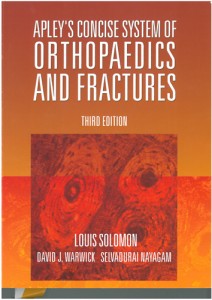Bachelor of Science
Fourth Year Medicine (Graduate)
University of Queensland
Tuesday, March 29th, 2011

Solomon L, Warwick D, Nayagam S. Apley’s Concise System of Orthopaedics and Fractures. 3rd ed. London (UK): Hodder Arnold; 2005.
RRP AU$52.65
The 2006-2007 Australian Hospital Statistics demonstrated that fractures alone accounted for 173,410 separations from Australian Hospitals. [1] As such, all interns will see a potential orthopaedic patient at least once in their Emergency rotation and will require a sound knowledge of orthopaedics. Like all medical fields, knowledge is gathered from clinical rotations, doctors and peers. However, this learning will need to be supplemented with textbook study. One of the most popular medical student level textbooks for orthopaedics is Apley’s Concise System of Orthopaedics and Fractures. Currently in its third edition, Apley’s provides 390 pages of musculoskeletal medicine ranging from the classification and management of basic fractures to more obscure genetic conditions such as brittle bone disease.
Apley’s is separated into three general categories: General orthopaedics, Regional orthopaedics and Fractures and joint injuries. Each Orthopaedic condition is explained in the time-honoured method of history, examination findings, imaging and investigation findings, and management. This provides medical students with a well-structured and concise guide to the signs and symptoms of each specific condition. Furthermore, for some of the more common musculoskeletal conditions, such as osteoarthritis, considerable time has been donated to the pathophysiology and both the operative and non-operative treatment options.
One of the criticisms of this text is that there is information on some of the more obscure genetic orthopaedic conditions, unlikely to be useful in the acute setting. The section on fractures is detailed and provides information on the different types of fractures possible for every bone. For the average medical student on a standard orthopaedic rotation, it is unlikely that they will remember all of the specifics of each fracture type and eponyms, let alone their management. Further, Apley’s provides minimal therapeutic drug classification and doses for the management of some of the medically treated orthopaedic conditions.
A sufficient grounding in orthopaedics is essential for any intern. A significant proportion of this textbook is dedicated to fracture diagnosis and management, invaluable for the Emergency Department setting where acute traumatic injuries are more commonly treated, rather than progressive chronic conditions. Apley’s Concise System of Orthopaedics and Fractures provides an easy-to-read textbook for students wishing to learn the basics of the diagnosis and management of common orthopaedic conditions.
None declared.
[1] Australian Institute of Health and Welfare. Australian Hospital Statistics 2006-2007 [Internet]. Canberra: Australian Government; 2008 [updated 2008 May; cited 2010 July 10]. Available from:URL: http://www.aihw.gov.au/publications/hse/ahs06-07/ahs06-07.pdf
